low oil pressure HYUNDAI SONATA LIMITED 2021 Owners Manual
[x] Cancel search | Manufacturer: HYUNDAI, Model Year: 2021, Model line: SONATA LIMITED, Model: HYUNDAI SONATA LIMITED 2021Pages: 546, PDF Size: 51.21 MB
Page 96 of 546
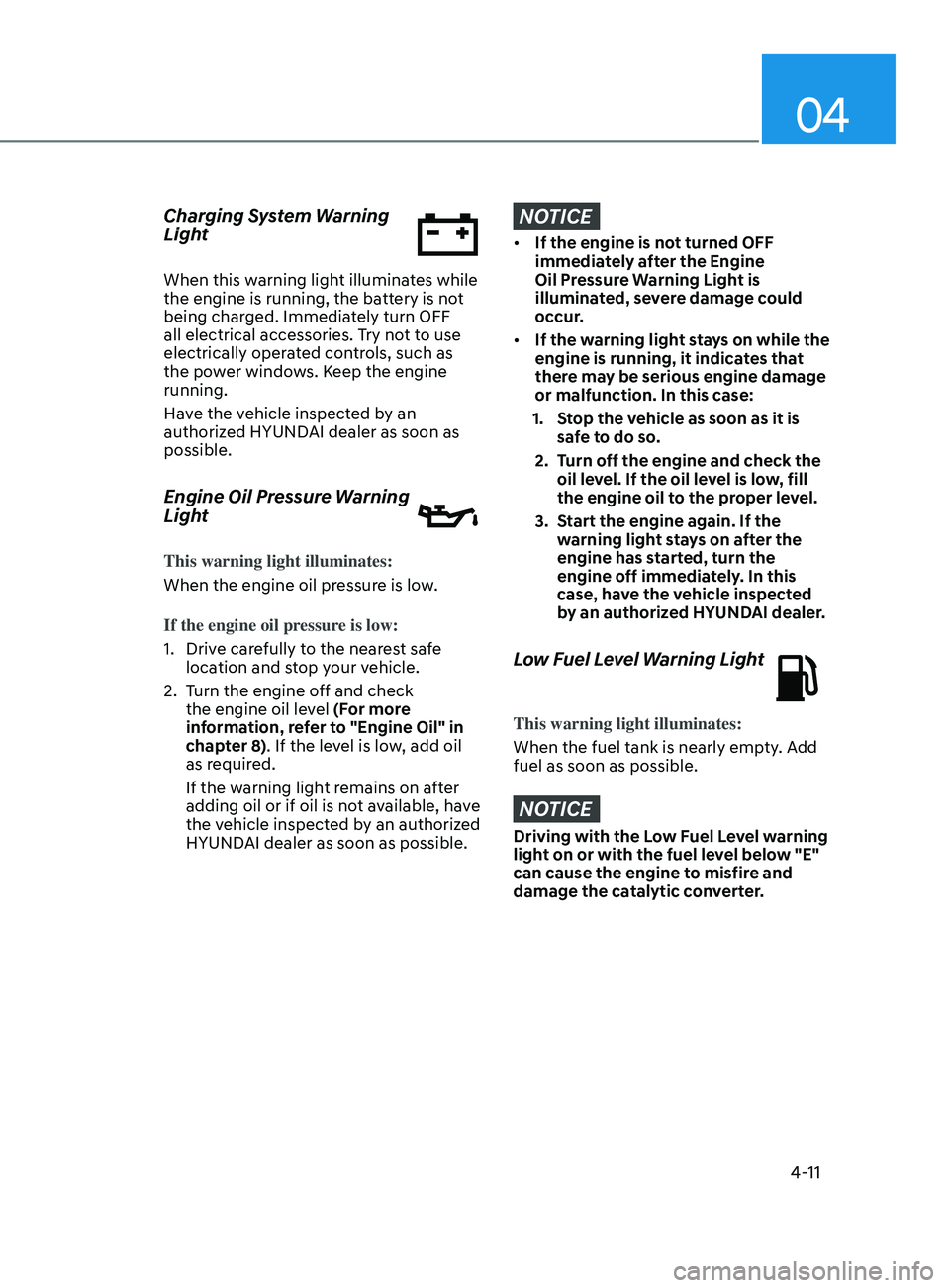
04
4-11
Charging System Warning
Light
When this warning light illuminates while
the engine is running, the battery is not
being charged. Immediately turn OFF
all electrical accessories. Try not to use
electrically operated controls, such as
the power windows. Keep the engine
running.
Have the vehicle inspected by an
authorized HYUNDAI dealer as soon as
possible.
Engine Oil Pressure Warning
Light
This warning light illuminates:
When the engine oil pressure is low.
If the engine oil pressure is low:
1.
Driv
e carefully to the nearest safe
location and stop your vehicle.
2.
T
urn the engine off and check
the engine oil level (For more
information, refer to "Engine Oil" in
chapter 8). If the level is low, add oil
as required.
If the warning light remains on after
adding oil or if oil is not available, have
the vehicle inspected by an authorized
HYUNDAI dealer as soon as possible.
NOTICE
• If the engine is not turned OFF
immediately after the Engine
Oil Pressure Warning Light is
illuminated, severe damage could
occur.
• If the warning light stays on while the
engine is running, it indicates that
there may be serious engine damage
or malfunction. In this case:
1.
S
top the vehicle as soon as it is
safe to do so.
2.
T
urn off the engine and check the
oil level. If the oil level is low, fill
the engine oil to the proper level.
3.
S
tart the engine again. If the
warning light stays on after the
engine has started, turn the
engine off immediately. In this
case, have the vehicle inspected
by an authorized HYUNDAI dealer.
Low Fuel Level Warning Light
This warning light illuminates:
When the fuel tank is nearly empty. Add
fuel as soon as possible.
NOTICE
Driving with the Low Fuel Level warning
light on or with the fuel level below "E"
can cause the engine to misfire and
damage the catalytic converter.
Page 256 of 546
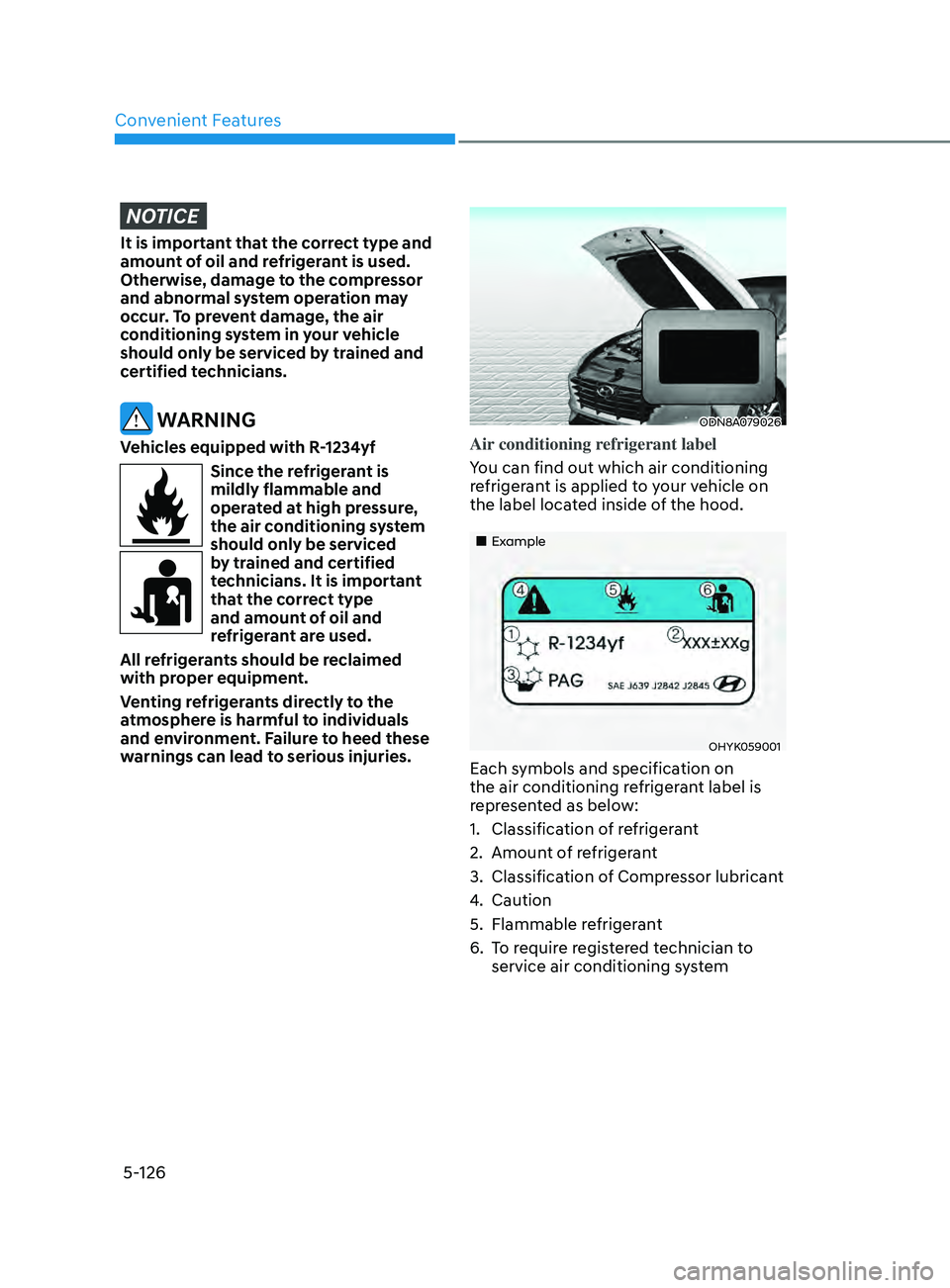
Convenient Features
5-126
NOTICE
It is important that the correct type and
amount of oil and refrigerant is used.
Otherwise, damage to the compressor
and abnormal system operation may
occur. To prevent damage, the air
conditioning system in your vehicle
should only be serviced by trained and
certified technicians.
WARNING
Vehicles equipped with R-1234yf
Since the refrigerant is
mildly flammable and
operated at high pressure,
the air conditioning system
should only be serviced
by trained and certified
technicians. It is important
that the correct type
and amount of oil and
refrigerant are used.
All refrigerants should be reclaimed
with proper equipment.
Venting refrigerants directly to the
atmosphere is harmful to individuals
and environment. Failure to heed these
warnings can lead to serious injuries.
ODN8A079026
Air conditioning refrigerant label
You can find out which air conditioning
refrigerant is applied to your vehicle on
the label located inside of the hood.
„„Example
OHYK059001
Each symbols and specification on
the air conditioning refrigerant label is
represented as below:
1.
Classifica
tion of refrigerant
2.
Amoun
t of refrigerant
3.
Classifica
tion of Compressor lubricant
4.
Caution
5.
Flammable r
efrigerant
6.
T
o require registered technician to
service air conditioning system
Page 267 of 546
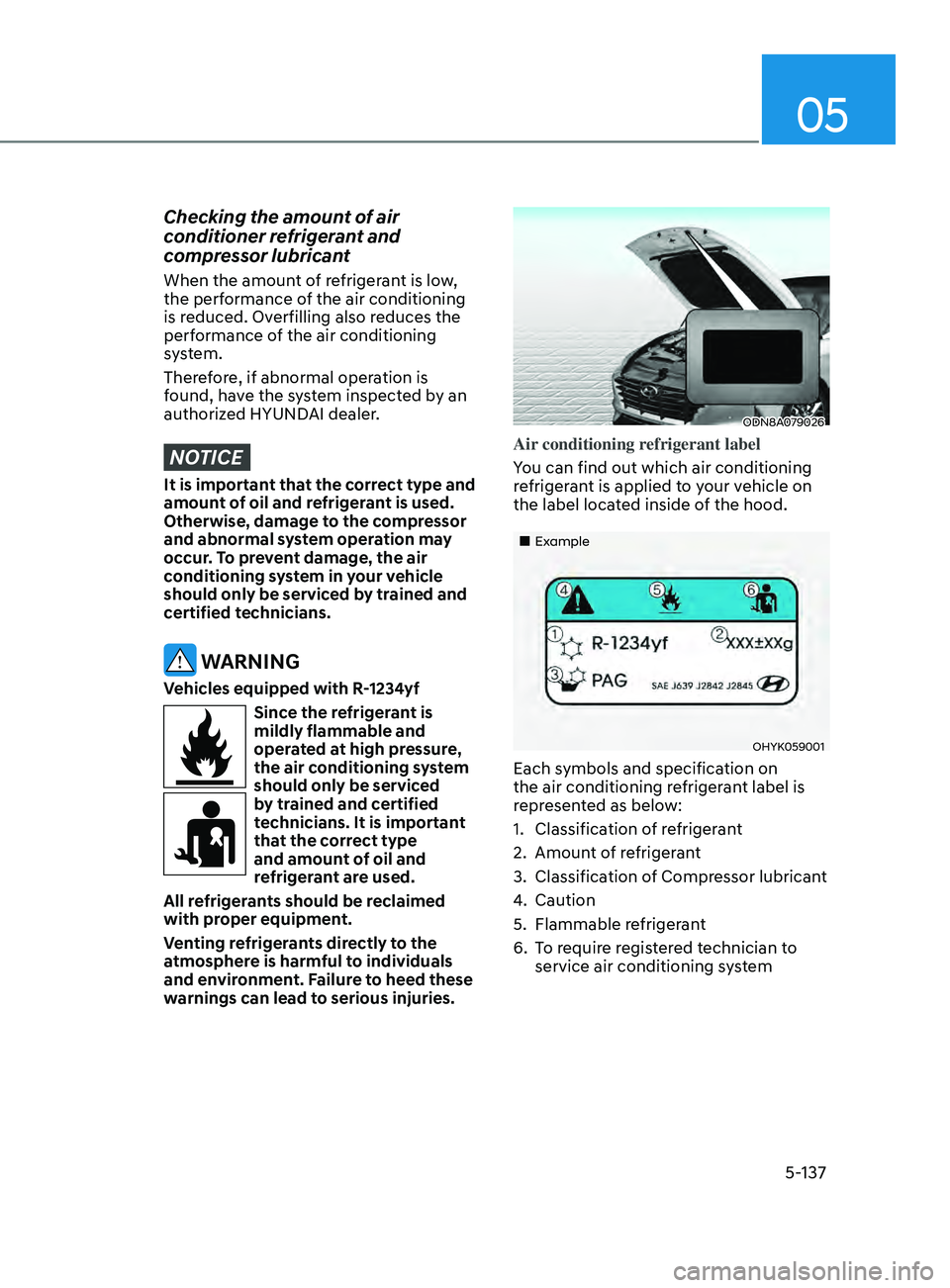
05
5-137
Checking the amount of air
conditioner refrigerant and
compressor lubricant
When the amount of refrigerant is low,
the performance of the air conditioning
is reduced. Overfilling also reduces the
performance of the air conditioning
system.
Therefore, if abnormal operation is
found, have the system inspected by an
authorized HYUNDAI dealer.
NOTICE
It is important that the correct type and
amount of oil and refrigerant is used.
Otherwise, damage to the compressor
and abnormal system operation may
occur. To prevent damage, the air
conditioning system in your vehicle
should only be serviced by trained and
certified technicians.
WARNING
Vehicles equipped with R-1234yf
Since the refrigerant is
mildly flammable and
operated at high pressure,
the air conditioning system
should only be serviced
by trained and certified
technicians. It is important
that the correct type
and amount of oil and
refrigerant are used.
All refrigerants should be reclaimed
with proper equipment.
Venting refrigerants directly to the
atmosphere is harmful to individuals
and environment. Failure to heed these
warnings can lead to serious injuries.
ODN8A079026
Air conditioning refrigerant label
You can find out which air conditioning
refrigerant is applied to your vehicle on
the label located inside of the hood.
„„Example
OHYK059001
Each symbols and specification on
the air conditioning refrigerant label is
represented as below:
1.
Classifica
tion of refrigerant
2.
Amoun
t of refrigerant
3.
Classifica
tion of Compressor lubricant
4.
Caution
5.
Flammable r
efrigerant
6.
T
o require registered technician to
service air conditioning system
Page 426 of 546
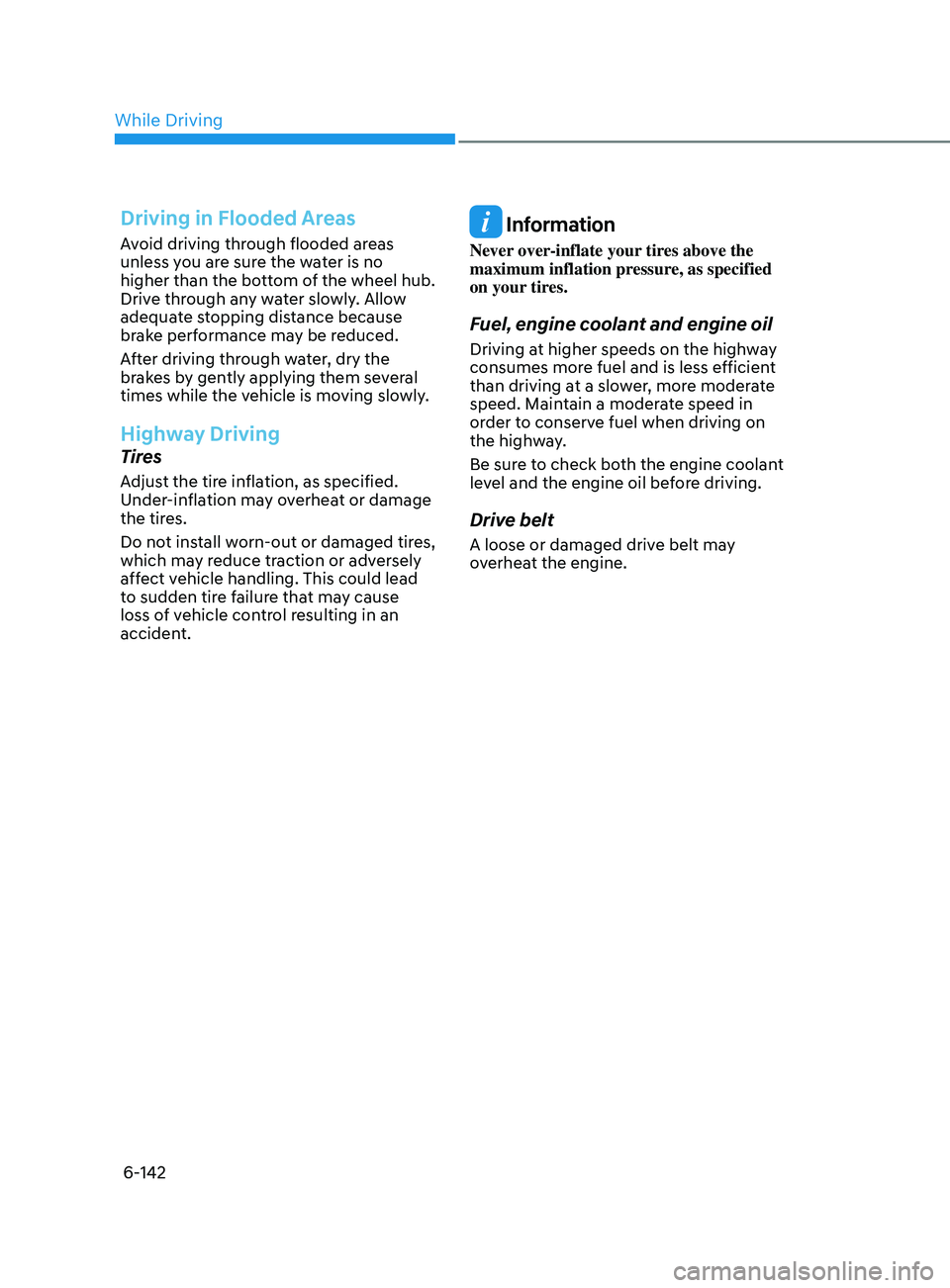
6-142
Driving in Flooded Areas
Avoid driving through flooded areas
unless you are sure the water is no
higher than the bottom of the wheel hub.
Drive through any water slowly. Allow
adequate stopping distance because
brake performance may be reduced.
After driving through water, dry the
brakes by gently applying them several
times while the vehicle is moving slowly.
Highway Driving
Tires
Adjust the tire inflation, as specified.
Under-inflation may overheat or damage
the tires.
Do not install worn-out or damaged tires,
which may reduce traction or adversely
affect vehicle handling. This could lead
to sudden tire failure that may cause
loss of vehicle control resulting in an
accident.
Information
Never over-inflate your tires above the
maximum inflation pressure, as specified
on your tires.
Fuel, engine coolant and engine oil
Driving at higher speeds on the highway
consumes more fuel and is less efficient
than driving at a slower, more moderate
speed. Maintain a moderate speed in
order to conserve fuel when driving on
the highway.
Be sure to check both the engine coolant
level and the engine oil before driving.
Drive belt
A loose or damaged drive belt may
overheat the engine.
While Driving
Page 457 of 546
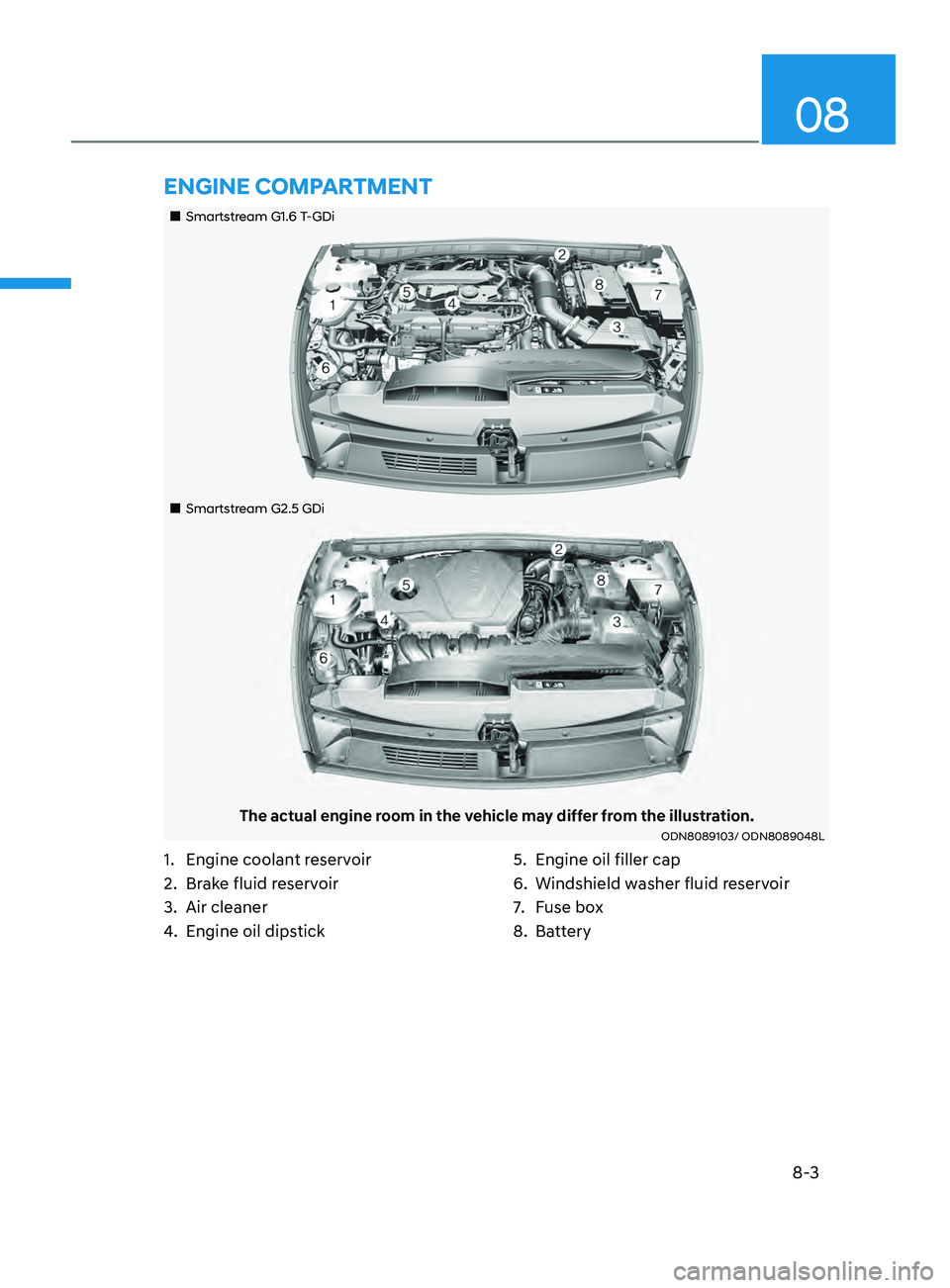
8-3
08
Tires and Wheels ........................................................................\
..................8-34Tire Care ........................................................................\
.......................................... 8-34
Recommended Cold Tire Inflation Pressures ....................................................... 8-34
Check Tire Inflation Pressure ........................................................................\
......... 8-35
Tire Rotation ........................................................................\
................................... 8-36
Wheel Alignment and Tire Balance ....................................................................... 8-37
Tire Replacement ........................................................................\
........................... 8-38
Wheel Replacement ........................................................................\
....................... 8-39
Tire Traction ........................................................................\
.................................... 8-39
Tire Maintenance........................................................................\
............................ 8-39
Tire Sidewall Labeling ........................................................................\
.................... 8-39
Tire Terminology and Definitions ........................................................................\
.. 8-43
All Season Tires ........................................................................\
............................... 8-46
Summer Tires ........................................................................\
................................. 8-46
Snow Tires........................................................................\
.......................................8-46
Radial-Ply Tires ........................................................................\
............................... 8-46
Low Aspect Ratio Tires ........................................................................\
................... 8-47
Fuses ........................................................................\
....................................8-48Instrument Panel Fuse Replacement .................................................................... 8-49
Engine Compartment Panel Fuse Replacement .................................................. 8-50
Fuse/Relay Panel Description........................................................................\
.........8-51
Light Bulbs ........................................................................\
............................ 8-57Headlamp, Parking Lamp, Daytime Running Light, Turn Signal Lamp,
Cornering Lamp and Side Marker ........................................................................\
. 8-57
Side Repeater Lamp Replacement ...................................................................... 8-58
Rear Combination Light Bulb Replacement ......................................................... 8-58
High Mounted Stop Lamp Replacement ............................................................. 8-60
License Plate Light Bulb Replacement ................................................................ 8-60
Interior Light Bulb Replacement ........................................................................\
... 8-61
Appearance Care ........................................................................\
................. 8-63Exterior Care ........................................................................\
................................... 8-63
Interior Care ........................................................................\
.................................... 8-67
Emission Control System ........................................................................\
.... 8-69
California perchlorate notice ...................................................................... 8-72
Consumer Information ........................................................................\
........ 8-73
Reporting Safety Defects ........................................................................\
.... 8 -74
1. Engine coolant reservoir
2.
Br
ake fluid reservoir
3.
Air cleaner
4.
E
ngine oil dipstick 5.
E ngine oil filler cap
6.
Windshield w
asher fluid reservoir
7.
F
use box
8.
Ba
ttery
EnginE CompartmEnt
„„Smartstream G1.6 T-GDi
„„Smartstream G2.5 GDi
The actual engine room in the vehicle may differ from the illustration.ODN8089103/ ODN8089048L
Page 518 of 546
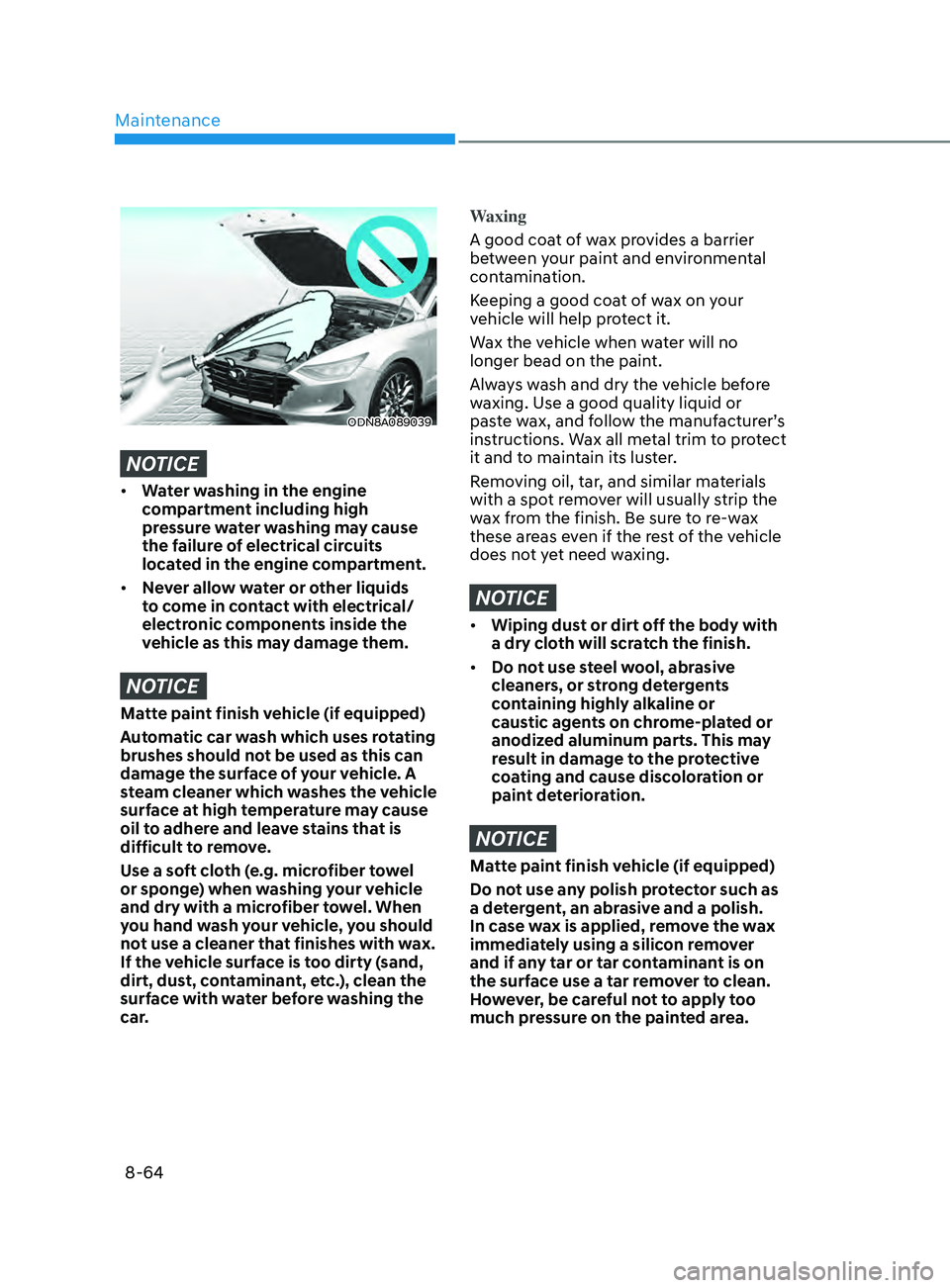
Maintenance
8-64
ODN8A089039
NOTICE
• Water washing in the engine
compartment including high
pressure water washing may cause
the failure of electrical circuits
located in the engine compartment.
• Never allow water or other liquids
to come in contact with electrical/
electronic components inside the
vehicle as this may damage them.
NOTICE
Matte paint finish vehicle (if equipped)
Automatic car wash which uses rotating
brushes should not be used as this can
damage the surface of your vehicle. A
steam cleaner which washes the vehicle
surface at high temperature may cause
oil to adhere and leave stains that is
difficult to remove.
Use a soft cloth (e.g. microfiber towel
or sponge) when washing your vehicle
and dry with a microfiber towel. When
you hand wash your vehicle, you should
not use a cleaner that finishes with wax.
If the vehicle surface is too dirty (sand,
dirt, dust, contaminant, etc.), clean the
surface with water before washing the
car.
Waxing
A good coat of wax provides a barrier
between your paint and environmental
contamination.
Keeping a good coat of wax on your
vehicle will help protect it.
Wax the vehicle when water will no
longer bead on the paint.
Always wash and dry the vehicle before
waxing. Use a good quality liquid or
paste wax, and follow the manufacturer’s
instructions. Wax all metal trim to protect
it and to maintain its luster.
Removing oil, tar, and similar materials
with a spot remover will usually strip the
wax from the finish. Be sure to re-wax
these areas even if the rest of the vehicle
does not yet need waxing.
NOTICE
• Wiping dust or dirt off the body with
a dry cloth will scratch the finish.
• Do not use steel wool, abrasive
cleaners, or strong detergents
containing highly alkaline or
caustic agents on chrome-plated or
anodized aluminum parts. This may
result in damage to the protective
coating and cause discoloration or
paint deterioration.
NOTICE
Matte paint finish vehicle (if equipped)
Do not use any polish protector such as
a detergent, an abrasive and a polish.
In case wax is applied, remove the wax
immediately using a silicon remover
and if any tar or tar contaminant is on
the surface use a tar remover to clean.
However, be careful not to apply too
much pressure on the painted area.
Page 521 of 546
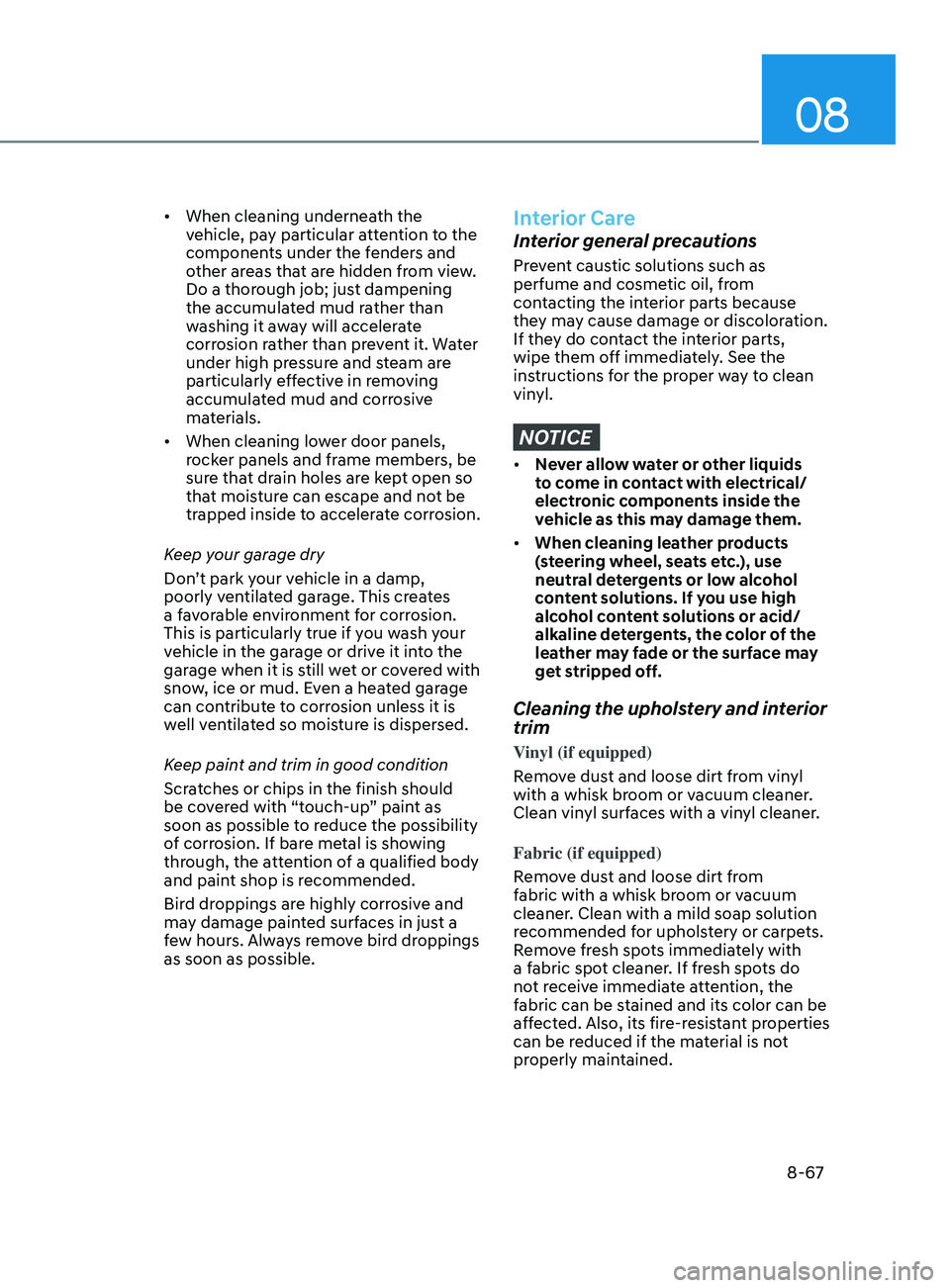
08
8-67
• When cleaning underneath the
vehicle, pay particular attention to the
components under the fenders and
other areas that are hidden from view.
Do a thorough job; just dampening
the accumulated mud rather than
washing it away will accelerate
corrosion rather than prevent it. Water
under high pressure and steam are
particularly effective in removing
accumulated mud and corrosive
materials.
• When cleaning lower door panels,
rocker panels and frame members, be
sure that drain holes are kept open so
that moisture can escape and not be
trapped inside to accelerate corrosion.
Keep your garage dry
Don’t park your vehicle in a damp,
poorly ventilated garage. This creates
a favorable environment for corrosion.
This is particularly true if you wash your
vehicle in the garage or drive it into the
garage when it is still wet or covered with
snow, ice or mud. Even a heated garage
can contribute to corrosion unless it is
well ventilated so moisture is dispersed.
Keep paint and trim in good condition
Scratches or chips in the finish should
be covered with “touch-up” paint as
soon as possible to reduce the possibility
of corrosion. If bare metal is showing
through, the attention of a qualified body
and paint shop is recommended.
Bird droppings are highly corrosive and
may damage painted surfaces in just a
few hours. Always remove bird droppings
as soon as possible.Interior Care
Interior general precautions
Prevent caustic solutions such as
perfume and cosmetic oil, from
contacting the interior parts because
they may cause damage or discoloration.
If they do contact the interior parts,
wipe them off immediately. See the
instructions for the proper way to clean
vinyl.
NOTICE
• Never allow water or other liquids
to come in contact with electrical/
electronic components inside the
vehicle as this may damage them.
• When cleaning leather products
(steering wheel, seats etc.), use
neutral detergents or low alcohol
content solutions. If you use high
alcohol content solutions or acid/
alkaline detergents, the color of the
leather may fade or the surface may
get stripped off.
Cleaning the upholstery and interior
trim
Vinyl (if equipped)
Remove dust and loose dirt from vinyl
with a whisk broom or vacuum cleaner.
Clean vinyl surfaces with a vinyl cleaner.
Fabric (if equipped)
Remove dust and loose dirt from
fabric with a whisk broom or vacuum
cleaner. Clean with a mild soap solution
recommended for upholstery or carpets.
Remove fresh spots immediately with
a fabric spot cleaner. If fresh spots do
not receive immediate attention, the
fabric can be stained and its color can be
affected. Also, its fire-resistant properties
can be reduced if the material is not
properly maintained.
Page 545 of 546
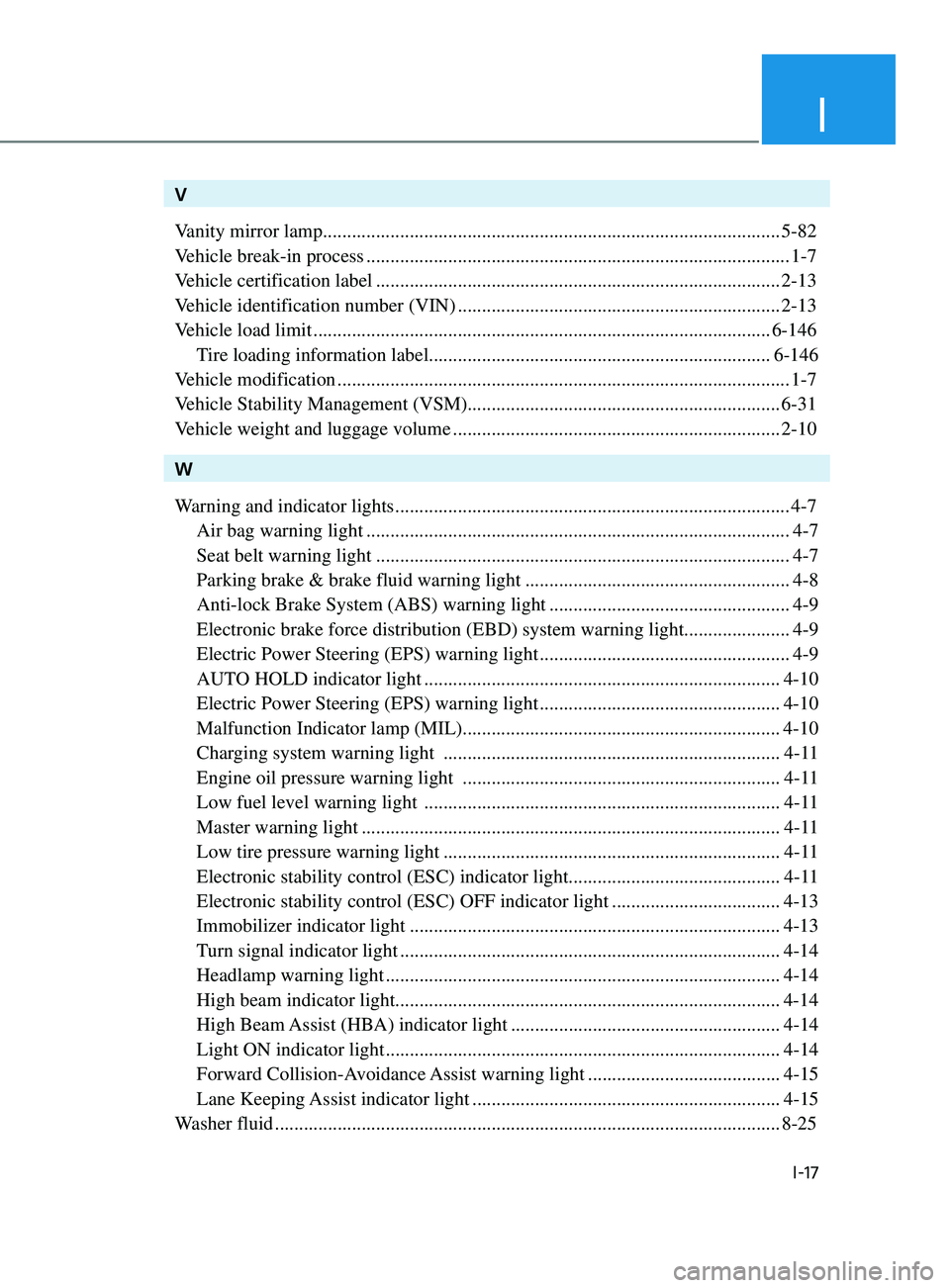
I
I-17
V
Vanity mirror lamp
........................................................................\
....................... 5-82
Vehicle break-in process
........................................................................\
................ 1-7
Vehicle certification label
........................................................................\
............ 2-13
Vehicle identification number (VIN)
................................................................... 2-13
Vehicle load limit
........................................................................\
....................... 6-146
Tire loading information label
....................................................................... 6-146
Vehicle modification
........................................................................\
...................... 1-7
Vehicle Stability Management (VSM)................................................................. 6-31
Vehicle weight and luggage volume
.................................................................... 2-10
W
Warning and indicator lights
........................................................................\
.......... 4-7
Air bag warning light
........................................................................\
................ 4-7
Seat belt warning light
........................................................................\
.............. 4-7
Parking brake & brake fluid warning light
.......................................................4-8
Anti-lock Brake System (ABS) warning light
.................................................. 4-9
Electronic brake force distribution (EBD) system warning light
...................... 4-9
Electric Power Steering (EPS) warning light
....................................................4-9
AUTO HOLD indicator light
........................................................................\
.. 4-10
Electric Power Steering (EPS) warning light
..................................................4-10
Malfunction Indicator lamp (MIL).................................................................. 4-10
Charging system warning light
...................................................................... 4-11
Engine oil pressure warning light
.................................................................. 4-11
Low fuel level warning light
........................................................................\
.. 4-11
Master warning light
........................................................................\
............... 4-11
Low tire pressure warning light
...................................................................... 4-11
Electronic stability control (ESC) indicator light............................................ 4-11
Electronic stability control (ESC) OFF indicator light
................................... 4-13
Immobilizer indicator light
........................................................................\
..... 4-13
Turn signal indicator light
........................................................................\
....... 4-14
Headlamp warning light
........................................................................\
.......... 4-14
High beam indicator light........................................................................\
........ 4-14
High Beam
Assist (HBA) indicator light
........................................................ 4-14
Light ON indicator light
........................................................................\
.......... 4-14
Forward Collision-Avoidance Assist warning light
........................................4-15
Lane Keeping Assist indicator light
................................................................ 4-15
Washer fluid
........................................................................\
................................. 8-25